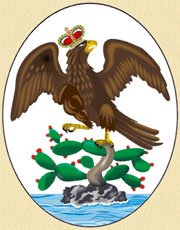- Articles Index
- Monthly Features
- General History Articles
- Ancient Near East
- Classical Europe and Mediterranean
- East Asia
- Steppes & Central Asia
- South and SE Asia
- Medieval Europe
- Medieval Iran & Islamic Middle East
- African History (-1750)
- Pre-Columbian Americas
- Early Modern Era
- 19'th Century (1789-1914)
- 20'th Century
- 21'st Century
- Total Quiz Archive
- Access Account
Mexican Empire I (1821-1832)
By Spartacus
Category: 19th Century: Political History
In the early 19th century AD, Mexico was in turmoil. The Mexican people were bitterly split... the rich were strongly Roman Catholics, loyal to the Spanish crown, and indignant to the poorer population of Mexico. In 1810, the Hidalgo revolt took place and rebellion was sweeping the land. Turmoil continued until December 1820, when Viceroy Juan Ruiz de Apodaca sent his army, led by Augustín de Iturbide, to defeat the rebels in Oaxaca. Around the same time, Ferdinand VII of Spain signed a liberal constitution under fear of an American-like revolution breaking out in Spain.
The news outraged the rich conservative faction of Mexico and Iturbide saw opportunity knocking at his door. He set up the Army of Three Guarantees under the Plan of Iguala. The first guarantee was that Mexico would become an independent monarchy with the throne being held by either King Ferdinand or another conservative European prince. The second guarantee was that Criollos and Peninsulares, two social classes in Mexico, would be given equality. The final guarantee, which particularly appealed to the rich population of Mexico, was that the Roman Catholic Church would keep its hold over Mexican religion. The Army of Three Guarantees was a combination of conservative, previously loyalist troops, and the rebels fighting for Mexican independence. The viceroy resigned seeing the obvious victory of the Army of Three Guarantees and on September 27, 1821, Mexican independence was officially recognized under the Plan of Iguala. A clause was included that stated if the Mexican congress could find no suitable European leader, a Mexican Criollo could take the throne.
Birth and Decline
Mexico had an independent congress set up, in accordance to the Plan of Iguala. Iturbide saw his power slipping and, on May 18, 1882, ordered his men to march through Mexico City in support of him. The march was joined by the people of the city and, as the great crowd reached Iturbide's home, the people cried, "Long live Agustín I, Emperor of Mexico!" Iturbide faked surprise gracefully. The following day, the congress declared Iturbide constitutional emperor.
It was not long before, the empire, which had annexed all of Spanish-speaking Central America, except Panama, faced serious economic problems. When modest tax adjustments failed, Iturbide became desperate, abolishing the legislative branch and arresting all opposition in August 1922. By mid-February 1823, Antonio López de Santa Anna Pérez de Lebrón (the leader of the Veracruz Garrison) had declared a republic and joined other revolutionaries in forming the Plan of Casa Mata. Iturbide abdicated the throne. The rebellion met no resistance as it marched into Mexico City. The United States of Central America declared independence in July, save the province of Chipas, previously of Guatamala. By 1824, a Federalist Republic had been formed.
|





